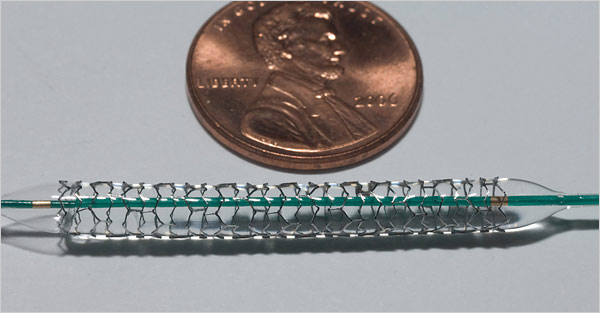 A stent. Source of photo: online version of the 3/27/07 NYT article cited below.
A stent. Source of photo: online version of the 3/27/07 NYT article cited below.
(p. C1) See, there was an elephant in the hearing room last week that went almost entirely ignored. One study after another has found that whether or not a stent is coated, angioplasty — the process of opening up an artery before a stent is inserted — and stenting do not actually reduce the risk of heart attack or extend life span for most patients.
“There’s a much more liberal use of angioplasty and stenting than there needs to be,” Dr. Eric J. Topol, a member of the panel, told me last week.
Dr. Calvin L. Weisberger, the top cardiologist at Kaiser Permanente, said, “A large pool of angioplasties and bypass surgeries are being done without scientific evidence.”
. . .
Angioplasty dates back to the 1970s, and stents became a part of the process in the 1990s. Doctors have assumed, sensibly enough, that blocked arteries caused heart attacks by preventing blood from reaching the heart. Opening those ar-(p. C14)teries would keep the blood flowing.
But when researchers tried to prove the theory, they kept coming up empty. The reason seems to be that heart attacks aren’t generally caused by a big buildup of plaque that blocks an artery. They occur instead when a small piece of plaque bursts, causing a cascade that can suddenly clog an open artery. The best way to reduce the risk of that is through cholesterol-lowering drugs, diet and exercise, rather than by opening up a couple of clogged arteries.
Yet stent use keeps growing. “Cardiologists just believe that if you open up a blockage, you’re going to help someone,” said Dr. Judith S. Hochman, director of the cardiovascular clinical research center at New York University. “And they make money from these procedures.”
Ah, yes — money. Medicare typically pays $12,000 to $15,000 for a coated stent procedure, according to Thomas Gunderson of Piper Jaffray. Angioplasty and stenting have accounted for almost 10 percent of the increase in Medicare spending since the mid-1990s, Jonathan S. Skinner, a Dartmouth economist, estimates.
For the full commentary, see:
Added on 3/22/08: For a later, related story, see:
